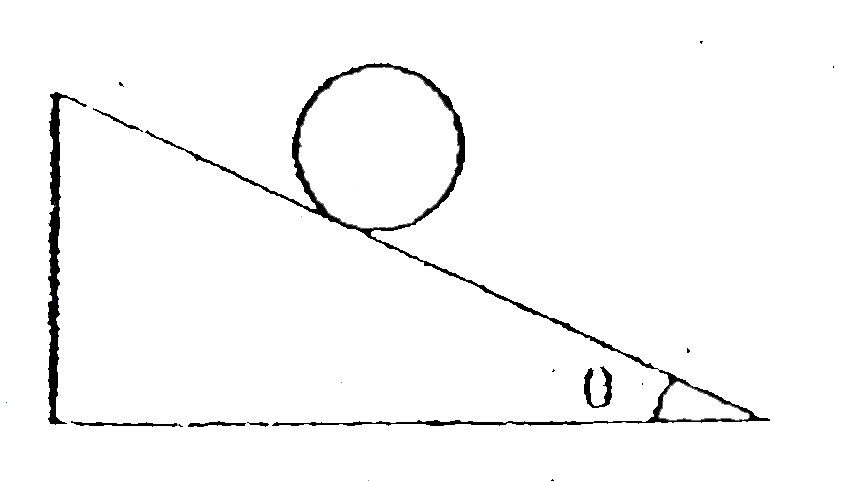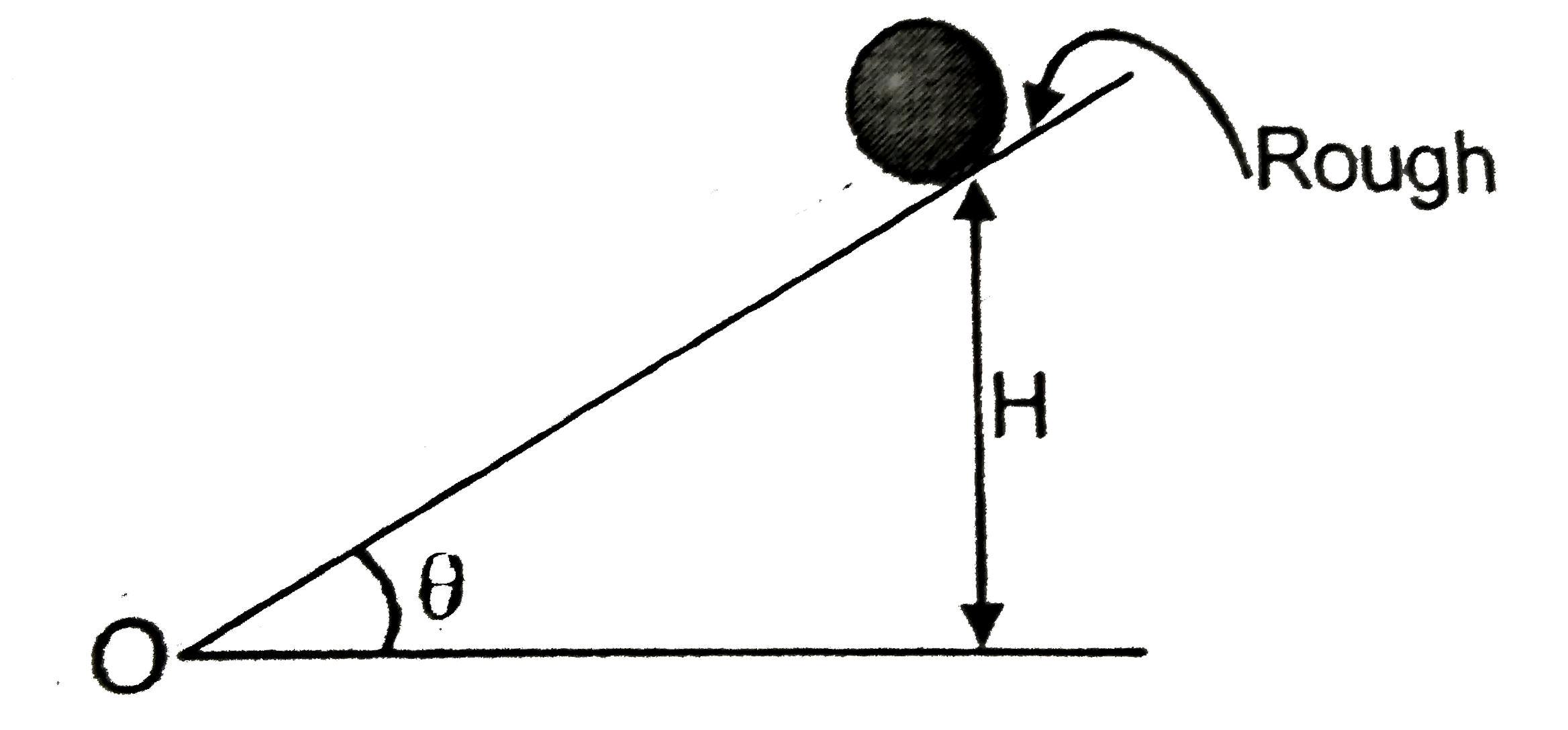A solid cylinder and a solid sphere, both having the same mass and radius, are released from a rough inclined plane of inclination θ one by one. They roll on the inclined plane without slipping. The force of friction that acts
Same for both the bodies
More for cylinder
More for sphere
Double for sphere than for cylinder
The correct Answer is:B
To solve the problem of comparing the force of friction acting on a solid cylinder and a solid sphere rolling down a rough inclined plane, we can follow these steps:
Step 1: Understand the System
We have a solid cylinder and a solid sphere, both with the same mass m and radius r. They roll down an inclined plane with an angle θ without slipping.
Step 2: Apply Conservation of Energy
The initial potential energy when the objects are at height h is converted into kinetic energy as they roll down.
The initial potential energy (PE) is given by:
PE=mgh
The final kinetic energy (KE) when they reach the bottom consists of translational and rotational kinetic energy:
KE=12mv2+12Iω2
For rolling without slipping, we have the relation v=rω.
Step 3: Moment of Inertia
The moment of inertia I for the solid cylinder is:
Icylinder=12mr2
For the solid sphere, it is:
Isphere=25mr2
Step 4: Set Up the Energy Equation
Using conservation of energy:
mgh=12mv2+12I(vr)2
Substituting the moment of inertia for both objects, we can express the equation for each.
For the Cylinder:
mgh=12mv2+12(12mr2)(v2r2)
This simplifies to:
mgh=12mv2+14mv2=34mv2
Thus,
v2=4gh3
For the Sphere:
mgh=12mv2+12(25mr2)(v2r2)
This simplifies to:
mgh=12mv2+15mv2=710mv2
Thus,
v2=10gh7
Step 5: Find the Acceleration
Using v2=u2+2as where u=0:
v2=2as⇒a=v22s
Substituting s=hsinθ:
- For the cylinder:
acylinder=4gh/32(h/sinθ)=2gsinθ3
- For the sphere:
asphere=10gh/72(h/sinθ)=5gsinθ7
Step 6: Calculate the Friction Force
Using the equation of motion and torque:
Ffriction⋅r=I⋅α
Where α=ar:
- For the cylinder:
Ffriction=Icylinder⋅ar2=12mr2⋅2gsinθ3r2=mgsinθ3
- For the sphere:
Ffriction=Isphere⋅ar2=25mr2⋅5gsinθ7r2=2mgsinθ7
Step 7: Compare the Friction Forces
- Friction force for the cylinder: Ffriction, cylinder=mgsinθ3
- Friction force for the sphere: Ffriction, sphere=2mgsinθ7
Since mgsinθ3>2mgsinθ7, the force of friction is greater for the solid cylinder.
Conclusion
The force of friction that acts more for the solid cylinder than for the solid sphere.
We have a solid cylinder and a solid sphere, both with the same mass m and radius r. They roll down an inclined plane with an angle θ without slipping.
The initial potential energy when the objects are at height h is converted into kinetic energy as they roll down.
PE=mgh
The final kinetic energy (KE) when they reach the bottom consists of translational and rotational kinetic energy:
KE=12mv2+12Iω2
For rolling without slipping, we have the relation v=rω.
The moment of inertia I for the solid cylinder is:
Icylinder=12mr2
For the solid sphere, it is:
Isphere=25mr2
Using conservation of energy:
mgh=12mv2+12I(vr)2
Substituting the moment of inertia for both objects, we can express the equation for each.
mgh=12mv2+12(12mr2)(v2r2)
This simplifies to:
mgh=12mv2+14mv2=34mv2
Thus,
v2=4gh3
mgh=12mv2+12(25mr2)(v2r2)
This simplifies to:
mgh=12mv2+15mv2=710mv2
Thus,
v2=10gh7
Using v2=u2+2as where u=0:
v2=2as⇒a=v22s
Substituting s=hsinθ:
- For the cylinder:
acylinder=4gh/32(h/sinθ)=2gsinθ3
- For the sphere:
asphere=10gh/72(h/sinθ)=5gsinθ7
Using the equation of motion and torque:
Ffriction⋅r=I⋅α
Where α=ar:
- For the cylinder:
Ffriction=Icylinder⋅ar2=12mr2⋅2gsinθ3r2=mgsinθ3
- For the sphere:
Ffriction=Isphere⋅ar2=25mr2⋅5gsinθ7r2=2mgsinθ7
- Friction force for the cylinder: Ffriction, cylinder=mgsinθ3
- Friction force for the sphere: Ffriction, sphere=2mgsinθ7
The force of friction that acts more for the solid cylinder than for the solid sphere.
Similar Questions
Knowledge Check
A hollow sphere and a solid sphere both having the same mass of 5 kg and radius 10 m are initially at rest. If they are made to roll down the same inclined plane without slipping, the ratio of their speeds when they reach the bottom of the plane VhollowVsolid, will be
A1B7√10C7√12D21√25
A solid sphere and a solid cylinder having the same mass and radius, rolls down the same incline. The ratio of their acceleration will be
View SolutionA solid cylinder and a hollow cylinder, both of the same mass and same external diameter are released from the same height at the same time on an inclined plane. Both roll down without slipping. Which one will reach the bottom first ?
View SolutionA solid cylinder is rolling down the inclined plane without slipping. Which of the following is correct?

View SolutionAssertion : A solid sphere and a ring of same mass and radius are released simultaneously from the top of an inclined surface. The two objects roll down the plane without slipping. They reach the bottom of the incline with equal linear speeds
Reason : Decrease in potential enery for both is the same.
View SolutionA disc and a solid sphere of same mass and radius roll down an inclined plane. The ratio of thhe friction force acting on the disc and sphere is
View SolutionA solid ball of mass 'm' is released on a rough fixed inclined plane from height H. The ball will perform pure rolling on the inclined plane. Then

View SolutionIf a solid cylinder rolls down an inclined plane, then its:
View Solution
